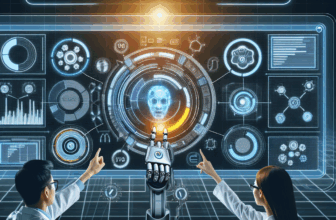Maximizing ROI: How AI-Powered Ad Targeting Optimization is Revolutionizing Marketing Strategy
Table of Contents
- 1. Introduction
- 2. Understanding AI-Powered Ad Targeting
- 3. Key Techniques in AI-Powered Ad Targeting
- 4. Benefits of AI-Powered Ad Targeting
- 5. Challenges in Implementing AI-Driven Strategies
- 6. Case Studies and Real-Life Examples
- 7. Future Trends in AI-Powered Marketing
- 8. Frequently Asked Questions (FAQs)
- 9. Resources
- 10. Conclusion
- 11. Disclaimer
1. Introduction
In today's digital landscape, businesses are continuously seeking innovative strategies to maximize return on investment (ROI) for their marketing efforts. One of the most powerful tools in this quest is artificial intelligence (AI), particularly in ad targeting optimization. As traditional marketing methods become less effective, AI offers a data-driven approach to reach the right audience at the right time, thus revolutionizing marketing strategies across industries.
This article explores how AI-powered ad targeting is transforming marketing strategies, identifies key techniques involved, examines benefits, addresses challenges for implementation, and illustrates its real-world application through case studies. As we navigate through this a comprehensive analysis, readers will gain insights on current trends and the future of AI in marketing.
2. Understanding AI-Powered Ad Targeting
2.1. Definition of AI-Powered Ad Targeting
AI-powered ad targeting leverages advanced algorithms and machine learning techniques to analyze vast amounts of data. This enables marketers to identify patterns and behaviors in consumer interactions and preferences, which are used to deliver more personalized advertising experiences. By implementing AI in ad targeting, businesses can automate decision-making processes, improve efficiency, and achieve better engagement rates.
2.2. How AI Differs from Traditional Marketing Techniques
Traditional marketing relies heavily on demographic factors such as age, gender, and location, often leading to broad and less personalized outreach. In contrast, AI-enabled strategies consider a myriad of factors, including user behaviors, interests, online interactions, and contextual data. This comprehensive understanding allows for hyper-targeted marketing approaches that can significantly increase conversion rates and customer satisfaction.
3. Key Techniques in AI-Powered Ad Targeting
3.1. Machine Learning Algorithms
Machine learning algorithms are at the heart of AI-powered ad targeting. These algorithms analyze historical data to identify trends and predict future behaviors of potential customers. By continuously learning from new data, machine learning models become increasingly accurate over time, allowing marketers to optimize their campaigns in real time. Techniques such as clustering, classification, and regression are often employed to segment audiences and tailor messaging accordingly.
3.2. Predictive Analytics
Predictive analytics involves the use of statistical algorithms and machine learning techniques to analyze historical data and anticipate future outcomes. In marketing, predictive analytics can forecast which customers are more likely to engage with specific ads, thereby guiding advertising efforts towards high-value targets. Marketers can leverage these insights to optimize ad placements, budget allocation, and creative strategies, ultimately enhancing ROI.
3.3. Natural Language Processing (NLP)
Natural Language Processing (NLP) enables machines to understand and interact with human language. In the context of ad targeting, NLP can analyze consumer sentiment from online reviews, social media interactions, and search queries. This information can be used to tailor advertising messages that resonate with audiences on a deeper emotional level, thereby increasing engagement and fostering brand loyalty.
4. Benefits of AI-Powered Ad Targeting
4.1. Enhanced Customer Insights
AI-powered ad targeting provides businesses with deeper insights into customer behavior than ever before. By analyzing patterns and preferences, marketers can develop a more detailed profile of their target audience. This allows for precise segmentation, enabling businesses to tailor their messaging and promotional strategies, leading to improved customer engagement and retention.
4.2. Improved Ad Relevance and Engagement
With AI, ads can be personalized based on user data and preferences. This relevance results in higher engagement rates, as consumers are more likely to interact with ads that reflect their interests and needs. Companies that invest in AI-driven ad targeting often see a significant increase in click-through rates (CTR) and conversions compared to traditional ad approaches.
4.3. Cost-Efficiency and Budget Optimization
AI optimizes advertising budgets by allocating resources to the most promising channels and demographics. By continuously analyzing performance data, AI can identify which ads yield the highest ROI and pivot spending accordingly. This dynamic budget optimization makes it possible for businesses to achieve better results without significantly increasing their marketing spend.
5. Challenges in Implementing AI-Driven Strategies
5.1. Data Privacy Concerns
One of the primary challenges of AI-powered ad targeting is the growing concern over data privacy. As regulations such as GDPR and CCPA impose strict guidelines on consumer data usage, businesses must be cautious in their approach to data collection. Marketers need to navigate these regulations skillfully to ensure compliance without sacrificing the effectiveness of their targeting strategies.
5.2. Algorithm Bias
Algorithms are only as good as the data they are trained on. AI systems can inadvertently perpetuate biases present in the data, leading to discriminatory practices in ad targeting. Companies must ensure that the data used to train their AI models is diverse and representative to mitigate these risks. Engaging in regular audits and adjustments to algorithms can help in recognizing and addressing potential biases.
5.3. Integration with Existing Systems
Integrating AI-driven ad targeting tools with current marketing platforms and processes can be challenging. Many organizations struggle with legacy systems that may not support modern AI technologies. It is crucial for companies to evaluate their existing infrastructure and consider investing in necessary upgrades or training to ensure a smooth integration process.
6. Case Studies and Real-Life Examples
6.1. Case Study: Amazon
Amazon is a leading example of how AI-powered ad targeting can drive business growth. By analyzing user behavior, Amazon can recommend products that align with customers’ interests, resulting in a highly personalized shopping experience. Their use of predictive analytics helps optimize ad placements on their platform, yielding impressive conversion rates and boosting overall sales significantly.
6.2. Case Study: Netflix
Netflix employs AI algorithms to tailor entertainment recommendations to its users based on viewing history and preferences. This personalized approach has not only improved viewer satisfaction but has also increased subscriber retention rates. By effectively targeting advertising, Netflix minimizes churn and maximizes the value of its advertising partnerships.
7. Future Trends in AI-Powered Marketing
7.1. Evolution of AI Technologies
The landscape of AI technologies is constantly evolving, with advancements in deep learning, neural networks, and automation reshaping marketing strategies. Future innovations in these areas are expected to result in even more accurate targeting, enhanced customer interactions, and more sophisticated personalization techniques. As businesses adopt these technologies, the competitive advantage will increasingly favor those who effectively leverage AI-driven insights.
7.2. Increasing Role of Voice Search
With the rise of smart speakers and voice-activated devices, voice search is becoming a critical channel for businesses to consider in their ad targeting strategies. Indigenous AI technologies can be employed to optimize content for voice search, ensuring that ads reach audiences through this emerging platform. As consumer behavior shifts towards voice queries, businesses must adapt their strategies and incorporate AI-driven insights to maintain visibility in this evolving space.
8. Frequently Asked Questions (FAQs)
Q1: How does AI improve targeting accuracy?
AI improves targeting accuracy by analyzing a wide range of data points, including consumer behavior patterns, historical interactions, and demographic details. Machine learning algorithms identify trends that allow marketers to tailor their campaigns specifically to potential buyers’ preferences.
Q2: What are the best practices for implementing AI in ad targeting?
Some best practices include ensuring data quality, regularly auditing algorithms to eliminate bias, ensuring compliance with data privacy regulations, and integrating AI with existing marketing systems effectively. Continuous training for marketing teams on AI tools is also crucial.
Q3: Can small businesses benefit from AI-powered ad targeting?
Absolutely! Small businesses can leverage AI tools to conduct targeted marketing campaigns efficiently. With the right analytics, they can compete against larger firms, optimizing their strategies to suit their budget while maximizing outreach and ROI.
9. Resources
| Source | Description | Link |
|---|---|---|
| Marketing AI Institute | Provides insights and resources on AI in marketing | Link |
| HubSpot | Offers a range of articles and guides on AI marketing | Link |
| IBM Watson | Features resources about AI and data analytics | Link |
| Statista | Offers statistics and reports on marketing trends | Link |
| Hootsuite | Provides best practices for social media marketing | Link |
10. Conclusion
AI-powered ad targeting is a transformative force in the marketing landscape, enabling businesses to enhance their ROI through personalized and data-driven strategies. As marketers increasingly adopt AI technologies, they gain valuable insights into consumer behavior, optimize advertising effectiveness, and simplify the complex process of reaching targeted audiences.
Future trends indicate a continual evolution of AI capabilities, further deepening personalization and encouraging new engagement methods. Businesses that prioritize understanding and integrating these innovations will not only enhance their marketing efforts but will also position themselves for competitive advantage in an increasingly digital world.
11. Disclaimer
This article is produced by A.I. and is in Beta Testing. While efforts have been made to provide accurate and up-to-date information, the content may not reflect recent changes or developments in the field of AI or marketing. The information in this article should serve as a general guide and not as definitive advice.
This article offers a detailed exploration of AI-powered ad targeting in marketing strategies, providing both foundational knowledge and insights into current trends and challenges. The comprehensive sections aim to equip readers with a thorough understanding of the topic, encouraging further study and application of these principles in real-world scenarios.










